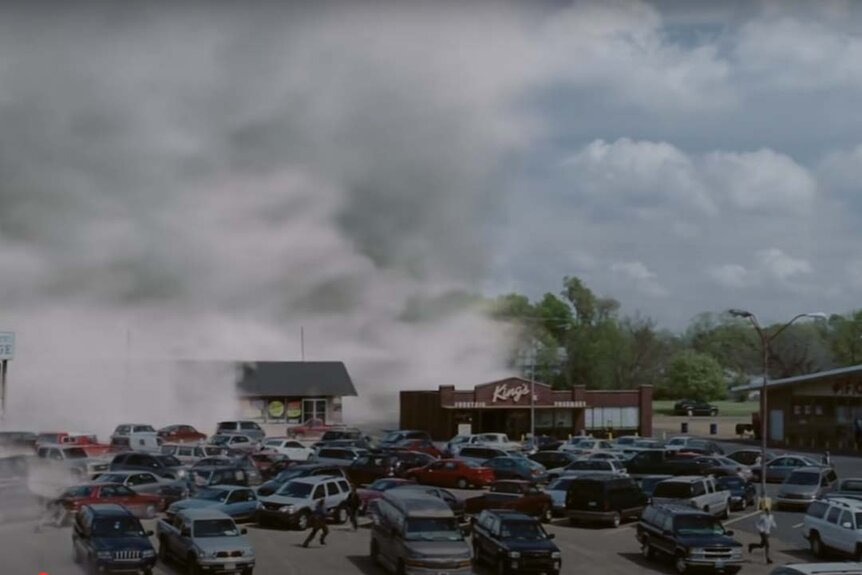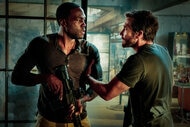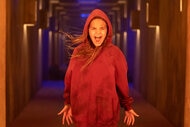Create a free profile to get unlimited access to exclusive videos, sweepstakes, and more!
Revisiting the Brutal, Jaw-Dropping Ending of Frank Darabont's The Mist
The Mist features one of the most devastating endings in mainstream horror history.
According to Stephen King, his novella The Mist (now streaming on Peacock) was inspired by a random image that occurred to him during a trip to a local market very much like the one depicted in the original story. He was moving through the crowd, looking for the items he needed, when his imagination conjured up a flying, prehistoric monster ripping through the store. It was enough to get started, and so we ended up with one of his most memorable tales.
In a lot of ways, the origins of The Mist are a good microcosm for what's made King the most popular genre author of his generation: A fusion of the ordinary and the extraordinary, the mundane and the monstrous, that at times feels so seamless that we can't help but expect his ideas to crawl out of the book and into our lives. It might sound simple, but it's the kind of thing that King does better than just about anyone, and understanding that goes a long way to making adaptations of his work land with audiences. Frank Darabont understands that, which explains why even when it's changing the source material, his film version of The Mist works as a perfect King story, right up to and including that devastating, relentless ending.
Why the Ending of Frank Darabont's The Mist Is So Devasting
To get a better idea of why that is, let's back up and recap what leads us to those final moments. David Drayton (Thomas Jane) heads to a local market with his son Billy (Nathan Gamble) to buy supplies in the wake of a storm. While they're there, monsters living in an unearthly mist surround the store and try to break in, leaving the customers inside fighting for their lives, and often fighting each other over the best way to survive. By the end of the struggle, David, Billy, and their friends Amanda (Laurie Holden), Dan (Jeffrey DeMunn), and Irene (Frances Sternhagen) have all piled into a car, hoping to find some kind of hope out in the mist. When they run out of gas with nothing in sight but the occasional colossal monster, they make a hard choice: suicide.
RELATED: The Mist at 15: Greg Nicotero Compares the Film to John Carpenter's The Thing
With only four bullets left in the revolver Amanda always carries with her, David makes the hardest choice of all, and shoots his young son and his three friends –– for all he knows, the only friends he has left in the whole world at that point –– before venturing outside to let the monsters eat him. What he finds instead, to his horror, is the United States military pushing through the mist, killing the creatures and saving his life.
It's an absolutely devastating ending, and a big change from the novel, which sees David and his friends simply driving onward into the mist, hearing vague radio messages that suggest some hope might be out there somewhere. It was Darabont's attempt to create something a bit more definitive, an ending that would not only stick with viewers, but leave them feeling the primal horror of The Mist long after the credits rolled. And it worked, so much so that even King agreed it's a better ending than his story.
But the ending of The Mist doesn't just land because it's a major downer at the end of a survival horror tale that, until that moment, suggested a bit more hope for its characters. No, the ending works because something about it goes all the way back to King's original vision, that moment of inspiration when a creature swept through his humdrum grocery store trip. The whole of The Mist, in both book and film versions, works as an expanded view of that idea, but it also works as a study in what happens when society starts to break down, when a community starts to fight not just an outside force, but itself. Through all those internal struggles in the market, we watch David and his allies work to build a community, despite failures and setbacks and violence, so that they can live to see another day.
RELATED: Why Stephen King Actually Prefers the Ending of The Mist Film Adaptation to That of His Own Novella
With Amanda, Dan, and Irene, David seems to have found that community. They've fought for reason, sanity, and even compassion over the course of the film, and as they drive into the mist at the end it seems they've found it, small and desperate though it may be. As humans who've all been in one desperate situation or another in our lives, we can understand this, the primal need to band together, to find some sense of common ground even when the whole world seems to have gone mad. It's a very relatable form of horror storytelling. And then Darabont pulls the rug out from under us.
In the end, after all that community building, that struggling, that standing up for hope and determination in the face of absolute terror, it all comes down to a moment of pragmatic defeat, of surrender, and our jaws are left on the floor not just because we know and care about these characters, but because Darabont makes us see just how fragile everything those characters built turns out to be. The Mist is frightening all the way through, but it's especially frightening in that moment, not because we see the worst happening, but because we understand thanks to a whole film's worth of great character development just how easily we could all veer into that kind of horror.
The Mist is now streaming on Peacock.































